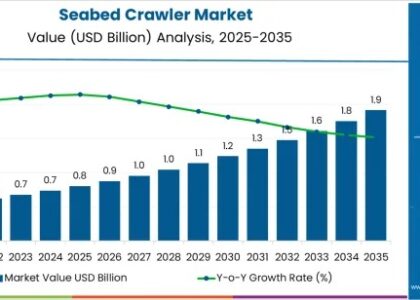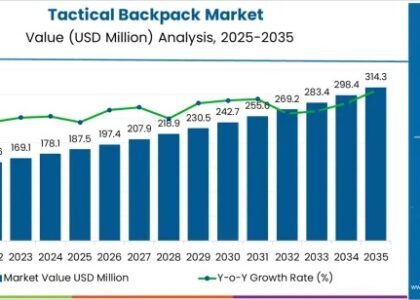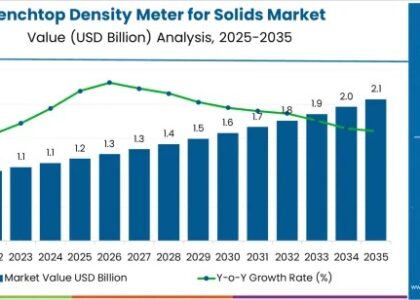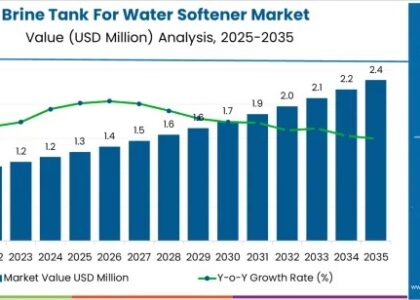The global healthcare and laboratory labels market share analysis is projected to exceed USD 11,219.8 million by 2035, growing at a compound annual growth rate (CAGR) of 2.7%. This steady expansion reflects a growing demand for advanced labeling solutions that align with industry-specific requirements, regulatory mandates, and technological evolution.
The market’s outlook is shaped by a convergence of drivers including patient safety concerns, digitization in healthcare, stringent labeling norms, and sustainable material innovations. The post-pandemic healthcare ecosystem has only accelerated the pace of transformation, making labeling not just a requirement, but a strategic advantage.
Unlock Growth Potential and Explore Market Opportunities With Our Comprehensive Industry Overview. Request Your Sample Now
https://www.futuremarketinsights.com/reports/sample/rep-gb-21480
Healthcare and laboratory labels are specialized identification solutions used across hospitals, diagnostics labs, pharmaceutical firms, and medical research centers. These labels are designed to withstand harsh environments such as cold storage, sterilization, chemical exposure, and abrasion, ensuring that critical information remains legible and intact.
More than just adhesive tags, they serve as communication tools embedded with patient data, regulatory information, medication details, or test results. They are engineered for precision, accountability, and traceability.
Surge in Demand for Regulatory-Compliant Labeling Solutions
With the healthcare sector being among the most regulated industries globally, compliance with FDA, EU MDR, and other region-specific regulatory bodies is non-negotiable. Labels used in this industry must meet strict criteria concerning durability, legibility, chemical resistance, and sterilization compatibility.
Healthcare providers and laboratories increasingly rely on compliant label formats to ensure accurate identification of medications, specimens, and patient records. Mislabeling or label deterioration can lead to diagnostic errors, making it imperative that solutions meet evolving regulatory mandates. This demand is driving innovations in tamper-evident and traceable labeling formats, especially for biologics, cold chain storage, and controlled substances.
Key Takeaways from the Healthcare & Laboratory Labels Market Share Analysis
- North America leads the market with a 40% share, driven by strict regulatory compliance and adoption of advanced labeling technologies.
- Europe holds a 35% market share, emphasizing sustainable and innovative labeling solutions.
- Asia-Pacific accounts for 20% of the market, witnessing rapid growth due to healthcare infrastructure expansion and modernization.
- Other regions contribute 10%, with rising demand for affordable and durable labeling solutions in emerging markets.
Patient Safety: A Primary Market Driver
Ensuring patient safety is a key driver for the adoption of advanced healthcare labeling systems. Labels used on medications, medical devices, and laboratory samples must ensure error-free identification, dosage accuracy, and data traceability throughout the supply chain.
From wristbands that track patient movement and treatment schedules to barcoded vials used in diagnostics, labeling solutions now integrate advanced technologies such as RFID tags, scannable QR codes, and serialization. These features help reduce human error, facilitate quick identification, and enhance inventory management in hospitals and diagnostic labs.
Technological Innovations in Labeling Materials and Adhesives
A significant portion of the market’s growth stems from the ongoing innovation in labeling materials and adhesives. Labels must now withstand extreme temperatures, humidity, chemical exposure, and sterilization processes (e.g., autoclaving).
Emerging materials such as polypropylene, polyimide, and polyester films, combined with medical-grade adhesives, ensure longevity and readability in challenging environments. Moreover, chemical-resistant coatings are becoming standard in laboratory settings where labels may come into contact with solvents, acids, or disinfectants.
Eco-Friendly Labels Reshaping Sustainability Strategies
Sustainability has become a priority for healthcare companies striving to reduce their environmental footprint. This is prompting a shift towards recyclable, biodegradable, and low-impact labeling materials.
Manufacturers are innovating by using water-based inks, compostable facestocks, and linerless labels to reduce waste. Labels designed to be easily removed and recycled with primary packaging are becoming increasingly popular, particularly in hospitals and clinical labs that deal with high-volume waste.
Role of Labeling in Cold Chain Management
Cold chain logistics, especially for biologics, vaccines, and certain types of diagnostic reagents, demand highly specialized labeling solutions. Labels must adhere securely to surfaces under sub-zero conditions and remain legible and scannable throughout the supply chain journey.
This has led to increased use of cryogenic labels, temperature-indicating labels, and ultra-durable synthetics that perform in harsh conditions. As cold chain demand surges globally, particularly post-COVID for vaccine distribution, this niche within the labeling industry is expanding rapidly.
Key Vendor Initiatives
- Avery Dennison: Develops RFID-enabled and recyclable labels for diverse applications.
- Brady Corporation: Expands its portfolio with durable and sustainable designs.
- 3M: Focuses on advanced materials for precision and compliance.
Top Segments Studied in the Healthcare & Laboratory Labels Market Share Analysis
By End-User:
- Hospitals
- Diagnostic Labs
- Pharmaceutical Companies
- Research Institutions
By Region:
- North America
- Europe
- Asia-Pacific
- Other Regions
About Future Market Insights (FMI)
Future Market Insights, Inc. (ESOMAR certified, recipient of the Stevie Award, and a member of the Greater New York Chamber of Commerce) offers profound insights into the driving factors that are boosting demand in the market. FMI stands as the leading global provider of market intelligence, advisory services, consulting, and events for the Packaging, Food and Beverage, Consumer Technology, Healthcare, Industrial, and Chemicals markets. With a vast team of over 400 analysts worldwide, FMI provides global, regional, and local expertise on diverse domains and industry trends across more than 110 countries.
Contact Us:
Future Market Insights Inc.
Christiana Corporate, 200 Continental Drive,
Suite 401, Newark, Delaware – 19713, USA
T: +1-347-918-3531
For Sales Enquiries: sales@futuremarketinsights.com
Website: https://www.futuremarketinsights.com
LinkedIn| Twitter| Blogs | YouTube
The global healthcare and laboratory labels market share analysis is projected to exceed USD 11,219.8 million by 2035, growing at a compound annual growth rate (CAGR) of 2.7%. This steady expansion reflects a growing demand for advanced labeling solutions that align with industry-specific requirements, regulatory mandates, and technological evolution.
The market’s outlook is shaped by a convergence of drivers including patient safety concerns, digitization in healthcare, stringent labeling norms, and sustainable material innovations. The post-pandemic healthcare ecosystem has only accelerated the pace of transformation, making labeling not just a requirement, but a strategic advantage.
Unlock Growth Potential and Explore Market Opportunities With Our Comprehensive Industry Overview. Request Your Sample Now
https://www.futuremarketinsights.com/reports/sample/rep-gb-21480
Healthcare and laboratory labels are specialized identification solutions used across hospitals, diagnostics labs, pharmaceutical firms, and medical research centers. These labels are designed to withstand harsh environments such as cold storage, sterilization, chemical exposure, and abrasion, ensuring that critical information remains legible and intact.
More than just adhesive tags, they serve as communication tools embedded with patient data, regulatory information, medication details, or test results. They are engineered for precision, accountability, and traceability.
Surge in Demand for Regulatory-Compliant Labeling Solutions
With the healthcare sector being among the most regulated industries globally, compliance with FDA, EU MDR, and other region-specific regulatory bodies is non-negotiable. Labels used in this industry must meet strict criteria concerning durability, legibility, chemical resistance, and sterilization compatibility.
Healthcare providers and laboratories increasingly rely on compliant label formats to ensure accurate identification of medications, specimens, and patient records. Mislabeling or label deterioration can lead to diagnostic errors, making it imperative that solutions meet evolving regulatory mandates. This demand is driving innovations in tamper-evident and traceable labeling formats, especially for biologics, cold chain storage, and controlled substances.
Key Takeaways from the Healthcare & Laboratory Labels Market Share Analysis
- North America leads the market with a 40% share, driven by strict regulatory compliance and adoption of advanced labeling technologies.
- Europe holds a 35% market share, emphasizing sustainable and innovative labeling solutions.
- Asia-Pacific accounts for 20% of the market, witnessing rapid growth due to healthcare infrastructure expansion and modernization.
- Other regions contribute 10%, with rising demand for affordable and durable labeling solutions in emerging markets.
Patient Safety: A Primary Market Driver
Ensuring patient safety is a key driver for the adoption of advanced healthcare labeling systems. Labels used on medications, medical devices, and laboratory samples must ensure error-free identification, dosage accuracy, and data traceability throughout the supply chain.
From wristbands that track patient movement and treatment schedules to barcoded vials used in diagnostics, labeling solutions now integrate advanced technologies such as RFID tags, scannable QR codes, and serialization. These features help reduce human error, facilitate quick identification, and enhance inventory management in hospitals and diagnostic labs.
Technological Innovations in Labeling Materials and Adhesives
A significant portion of the market’s growth stems from the ongoing innovation in labeling materials and adhesives. Labels must now withstand extreme temperatures, humidity, chemical exposure, and sterilization processes (e.g., autoclaving).
Emerging materials such as polypropylene, polyimide, and polyester films, combined with medical-grade adhesives, ensure longevity and readability in challenging environments. Moreover, chemical-resistant coatings are becoming standard in laboratory settings where labels may come into contact with solvents, acids, or disinfectants.
Eco-Friendly Labels Reshaping Sustainability Strategies
Sustainability has become a priority for healthcare companies striving to reduce their environmental footprint. This is prompting a shift towards recyclable, biodegradable, and low-impact labeling materials.
Manufacturers are innovating by using water-based inks, compostable facestocks, and linerless labels to reduce waste. Labels designed to be easily removed and recycled with primary packaging are becoming increasingly popular, particularly in hospitals and clinical labs that deal with high-volume waste.
Role of Labeling in Cold Chain Management
Cold chain logistics, especially for biologics, vaccines, and certain types of diagnostic reagents, demand highly specialized labeling solutions. Labels must adhere securely to surfaces under sub-zero conditions and remain legible and scannable throughout the supply chain journey.
This has led to increased use of cryogenic labels, temperature-indicating labels, and ultra-durable synthetics that perform in harsh conditions. As cold chain demand surges globally, particularly post-COVID for vaccine distribution, this niche within the labeling industry is expanding rapidly.
Key Vendor Initiatives
- Avery Dennison: Develops RFID-enabled and recyclable labels for diverse applications.
- Brady Corporation: Expands its portfolio with durable and sustainable designs.
- 3M: Focuses on advanced materials for precision and compliance.
Top Segments Studied in the Healthcare & Laboratory Labels Market Share Analysis
By End-User:
- Hospitals
- Diagnostic Labs
- Pharmaceutical Companies
- Research Institutions
By Region:
- North America
- Europe
- Asia-Pacific
- Other Regions
About Future Market Insights (FMI)
Future Market Insights, Inc. (ESOMAR certified, recipient of the Stevie Award, and a member of the Greater New York Chamber of Commerce) offers profound insights into the driving factors that are boosting demand in the market. FMI stands as the leading global provider of market intelligence, advisory services, consulting, and events for the Packaging, Food and Beverage, Consumer Technology, Healthcare, Industrial, and Chemicals markets. With a vast team of over 400 analysts worldwide, FMI provides global, regional, and local expertise on diverse domains and industry trends across more than 110 countries.
Contact Us:
Future Market Insights Inc.
Christiana Corporate, 200 Continental Drive,
Suite 401, Newark, Delaware – 19713, USA
T: +1-347-918-3531
For Sales Enquiries: sales@futuremarketinsights.com
Website: https://www.futuremarketinsights.com
LinkedIn| Twitter| Blogs | YouTube






